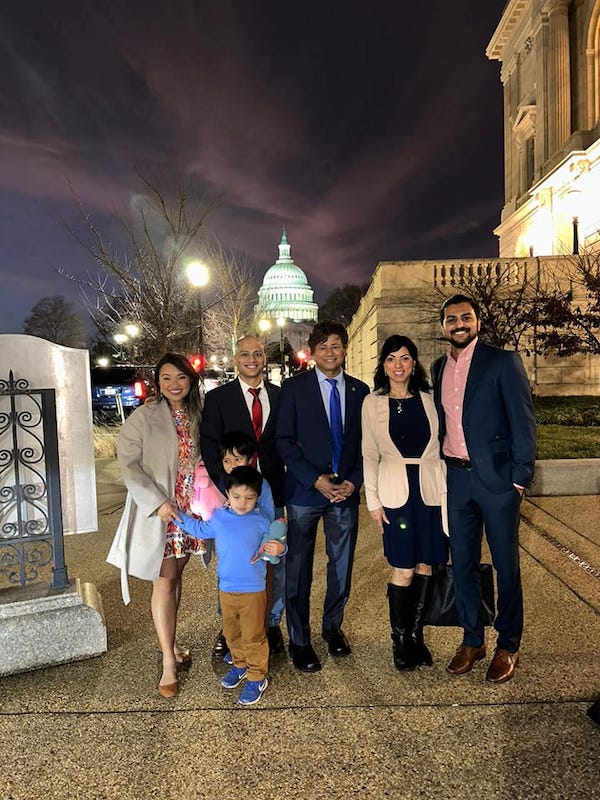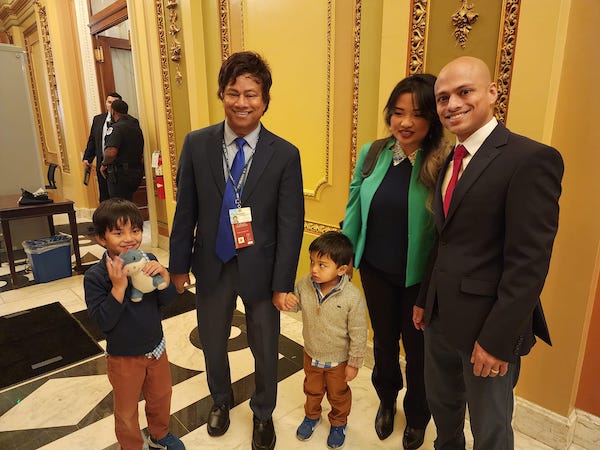Mr. Thanedar Goes to Washington: The New Indian American Congressman is Unlike his Colleagues in the Samosa Caucus
- The India-born-and-raised entrepreneur, who speaks with a thick Indian accent, has a life story that resonated with the predominantly Black electorate of Michigan’s 13th District.

As a former Michigan State Representative, Rep. Shri Thanedar (D-Mich.) has served in minority for the last two years. Despite that, he and his party were able to get a lot done. Now the 67-year-old Indian American aims to draw on those experiences as he navigates his first term in the U.S. Congress. Thanedar, who represents Michigan’s 13th Congressional District, is among the 74 freshmen who was sworn in on Jan. 7 in the House of Representatives.
The India-born-and-raised entrepreneur and self-made millionaire defeated his Black Republican challenger Martell Bivings by a landslide from an overwhelmingly Democratic district. He becomes the newest member of the Samosa Caucus — and is the fifth Indian American member of the Congress — joining Reps. Ami Bera and Ro Khanna of California, Pramila Jayapal of Washington, and Raja Krishnamoorthi of Illinois.

American Kahani caught up with Thanedar a few days before he was sworn in. He spoke about his growing up years in India, his move to the U.S. and his rise as an entrepreneur and politician, his relationship with his predominantly Black district, and his calling for public service. “I am ready, I am excited,” to begin his first term in Congress, he told American Kahani. Noting that has devoted the rest of his life to public service, he said he is “grateful for the trust that the people of my district, Detroit and the downriver communities have put into me.” He feels “a tremendous sense of responsibility to deliver to the people who have put so much trust in me.”
He is hopeful that his experiences of being a politician belonging to the minority party in the Michigan State House will hold him in good stead in a Republican majority House. “Whether we are majority or minority, we need to work on people’s needs, we need to work on making life better for all Americans, including my district.” To achieve that, he will be “working across the aisle.” With a “very thin majority,” he is confident that the GOP “is going to need us to get things done. Either we can have a gridlock, or we can reach across the aisle and still get things done.”
And Thar Accent
Although the passion and purpose of serving the country and its people is what unites everyone serving in the House of Representatives, Thanedar feels he’s a little different from the rest, including the four previously elected Indian American lawmakers.
He has lived in the U.S. for the last 43 years, having come to the country when he was 24, However, he still holds on to his Indian accent. “So, if you look at the five members of the Congress, two of them were born in the U.S. — Ro Khanna and Ami Bera — Raja Krishnamoorthi came to this country when he was three months old, and Pramila [Jayapal] came in when she was a young teen,” he explained. “In that way, there is a little bit of a hurdle, being an accented immigrant running for a seat in the U.S. Congress.”
He believes that one of the reasons we don’t see very many politicians with a foreign accent like him is because “a politician’s biggest skill is communication.” There’s also the perception that a person with an accent “isn’t American, or isn’t part of the mainstream,” he added. “Even though I’ve been living here for 43 years. Even though I’ve started businesses.”
The Constituents
Thanedar’s win is significant given that he is the first non-Black representative in over 70 years from the newly redrawn 13th District which covers most of Detroit, Hamtramck, the Grosse Pointes and the Downriver communities. He occupies the seat held by Democratic U.S. Rep. Brenda Lawrence of Southfield, who retired at the end of her term.
The district has no Indian Americans. There is a small Bangladeshi community in Hamtramck, but about 45 percent of the constituents are African American, 40 percent White, and approximately seven or eight percent Hispanic.
“Living in poverty, dealing with adversity, of never giving up, fighting, having that American Dream and achieving it,” connected with the African American community. The honesty and transparency with which he told his story also mattered.
When Thanedar ran for governor in 2018, he won the city of Detroit in the gubernatorial primary, which is about 78 percent African American. He beat the other two Democratic candidates — one of them being Gretchen Whitmer, who eventually became the governor of the state. “This is the only part of Michigan that I actually beat Whitmer,” he noted. “And that was interesting to me, because I didn’t live in Detroit then, and I did not particularly campaign more in Detroit than anywhere else. It was surprising to me to see that I had a huge support among the African American community.”
This support continued and strengthened during his Congressional bid as well.
He thinks his story of “living in poverty, dealing with adversity, of never giving up, fighting, having that American Dream and achieving it,” connected with the African American community. The honesty and transparency with which he told his story also mattered. He talked about mental illness, having lost his first wife to it when his children were 4 and 8 years old. He talked about the struggles of taking care of his parents and taking care of their healthcare or of putting food on the table while growing up. He talked about working as a janitor, growing up. “That honesty, transparency, and struggles, resonated, even though I did not speak like them, I did not look like them, even though I did not grow up in these neighborhoods.”
The Inspiration
Thanedar grew up in Belgavi in Karnataka, although his family belongs to Maharashtra. His father’s side is from Sangli and his mother is from Kolhapur. It was his father’s second marriage because his first wife died very early when he had two daughters. Thanedar’s mother came from a very poor family of priests. She was around 18 years old when she married Thanedar’s father who was almost 14 years older than her. “But this woman — my mother — who could never finish her high school, came into our family, and not only raised the two stepdaughters but also raised another six kids — four girls and two boys,” he says with pride. “Our family had tough times and my mother stood strong. And a lot of my inspiration comes from my mother.”
The Breaking Point
Thanedar recalled a time as a young man in India in 1979 when coming to America was “life-changing” for him. He was 24, his family was struggling. “I had a job that paid me Rs. 800; I’d give 200 of that to my mother every month.” At the time, the only way to get out of that was coming to America, about which he didn’t know much. He always looked at it as the land of opportunities, “where I could do things.” He labored on what he calls “a breaking point” when he decided to finally leave India.

Thanedar was working a scientist on the Atomic Energy Commission at the Bhabha Atomic Research Center in Mumbai. His supervisor at the time — S.D. Soman — didn’t allow him to pursue a master’s degree part-time while working. However, when he did it and got a gold medal, and ranked first in his masters class, the supervisor said he would not recognize that to give him a promotion. “That was really the breaking point, and I said it’s time to leave from here, and go find places where my skills will be recognized.”
He came to the U.S. in 1979 and got his Ph.D. in chemistry and an MBA. He took out loans to buy a company he worked for, Chemir and built it from a $150,000 company to one with a revenue of $14 million before selling it for $26 million. Next, he started Avomeen Analytical Services, a chemical testing laboratory.
He sold the majority stakes in it in 2016 and, according to his campaign bio, retired to get involved in public service to answer “the call to fight for social, racial and economic justice.” He has a doctorate in chemistry from the University of Akron, a post-doctoral degree from the University of Michigan and a master’s in business administration from Fontbonne University, a private, non-profit institution in Missouri.
Thanedar and his wife Shashi live close to their two sons. One of them is married and has two kids, and the other is engaged.
The Vision
Thanedar refused to comment on the dynamics of race between the Indian American and the African American community. But he urged the Black and Brown communities, and the Asian Americans to come together. “To some extent, we all have faced similar discrimination and problems.” As there’s strength in numbers, he feels that each community “doesn’t have to fight its own battles alone.” Instead, he hopes “we all can come together to have this rainbow coalition that together can fight against the oppression, the injustice and the economic, social and racial inequity,” which “we need to address and fight.” He also urged the sharing of individual skills and expertise. “Some of us may have skills that others may not have, so we can really share our resources, share our skills,” he said. “There’s more to gain by these communities coming together than each of us staying in our separate silos.
The Calling
Thanedar is happy and proud to see the Indian American community becoming part of the mainstream. “While many of us came here for economic empowerment, gaining economic progress, there’s more to being a true American citizen,” he notes. “It’s not just business success, educational success, economic success, but we also need to give back to this country, that has given us so much, focus on social justice, and use our skills to make other people’s lives better.”
And that’s exactly what he did. He gave up his “very, very lucrative business” and decided to enter public service because he felt “there’s more to life than accumulating wealth.” The mission, the calling at this stage in his life is “to give back and make other people’s lives better.”
He hopes he sees a lot more of that in his community as well. “I see a lot of Indian American community in Michigan, and they are very proud to have for the first time an Indian American representing the state in the U.S. Congress.” At the same urges them, especially the second generation, “to participate in mainstream, to take on causes that are important to the general community and our nation, and participate, and truly become an American citizen.” That can be achieved by “not only having professional success,” but we being part of the political process. “That is how we are going to be in the mainstream and become a true American citizen.”



Very well deserved!